
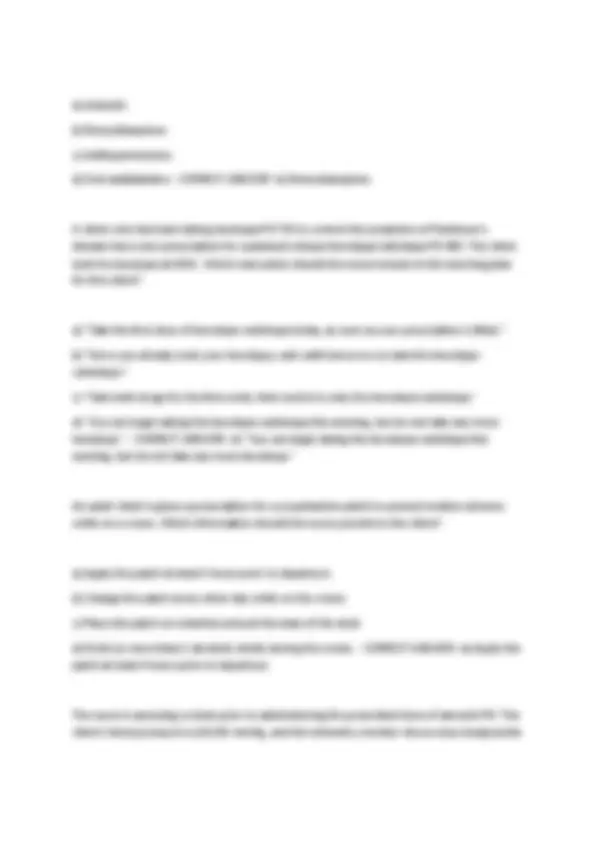
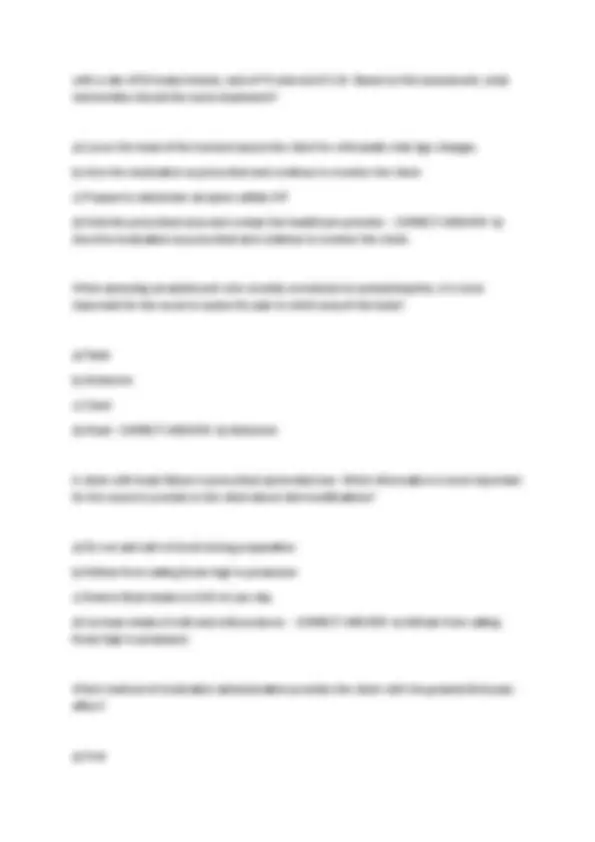
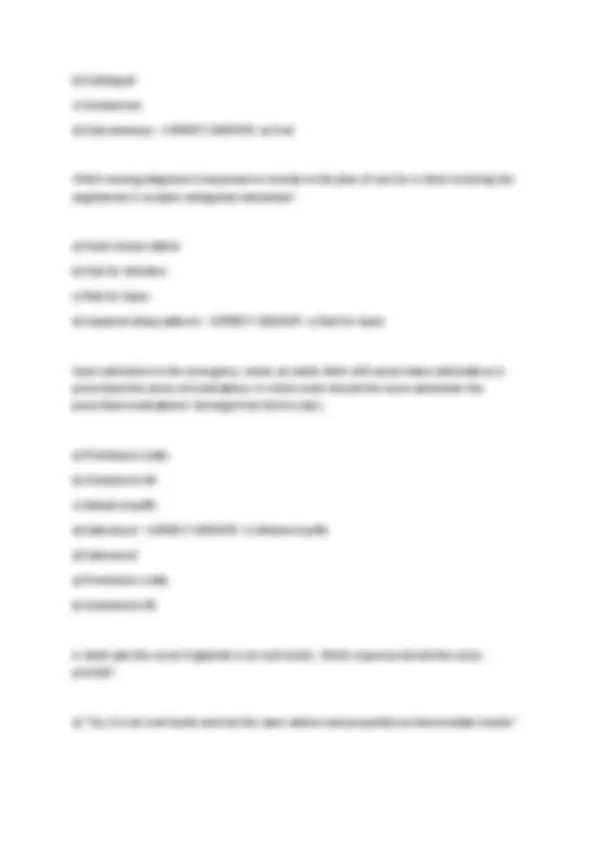
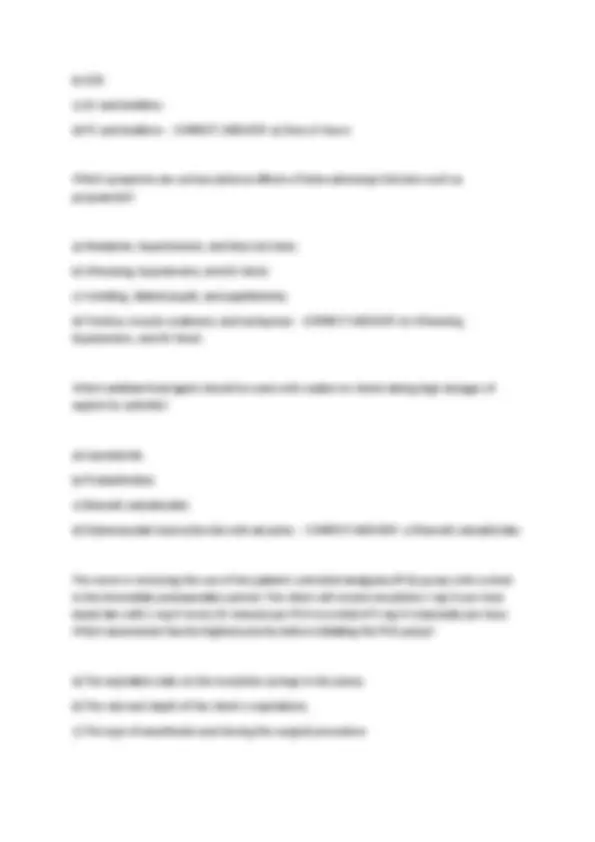
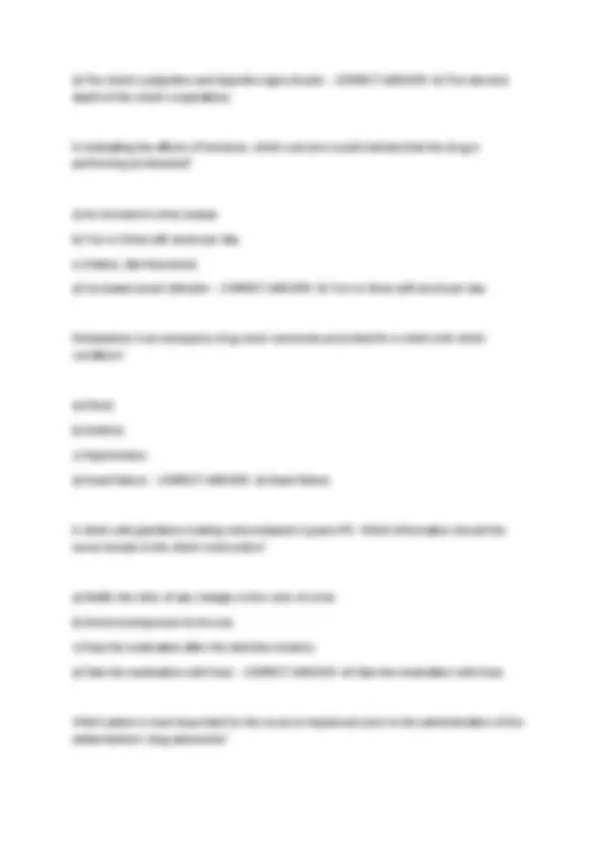
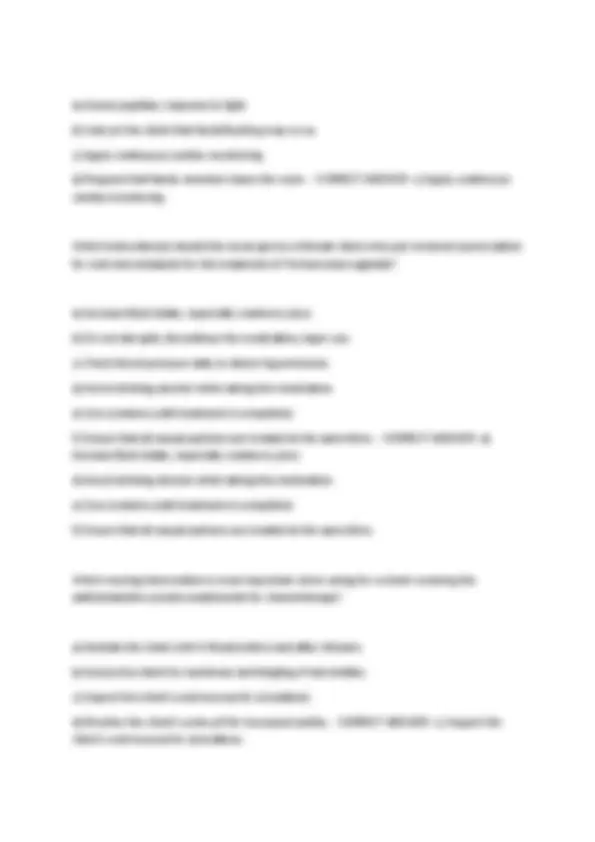
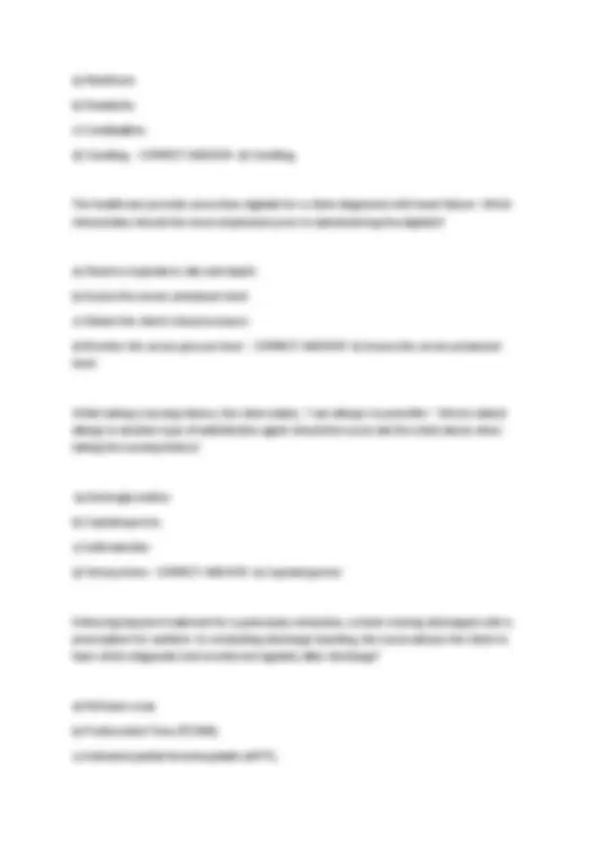
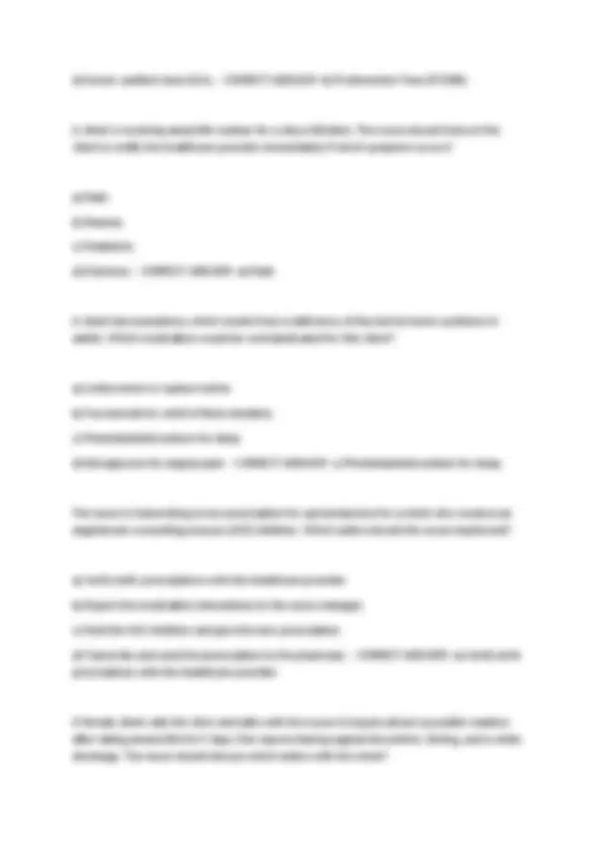
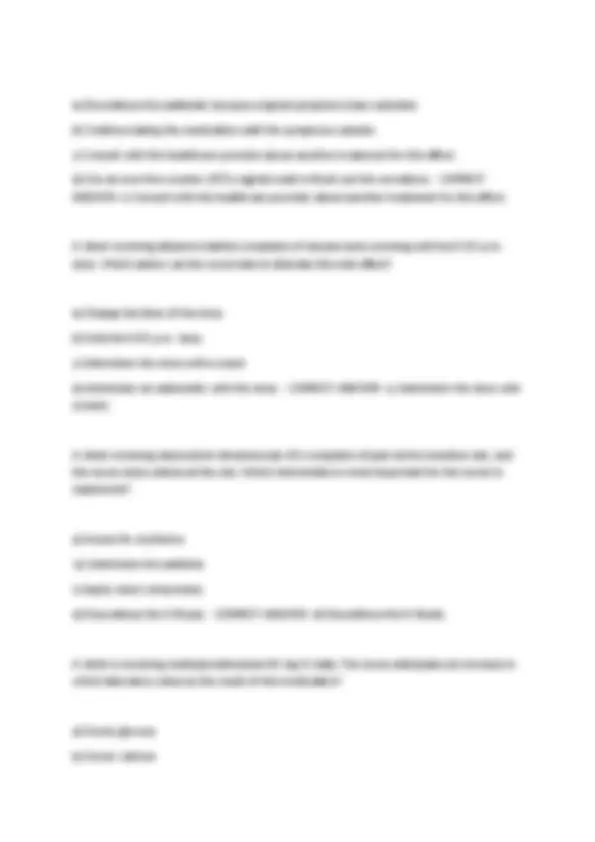
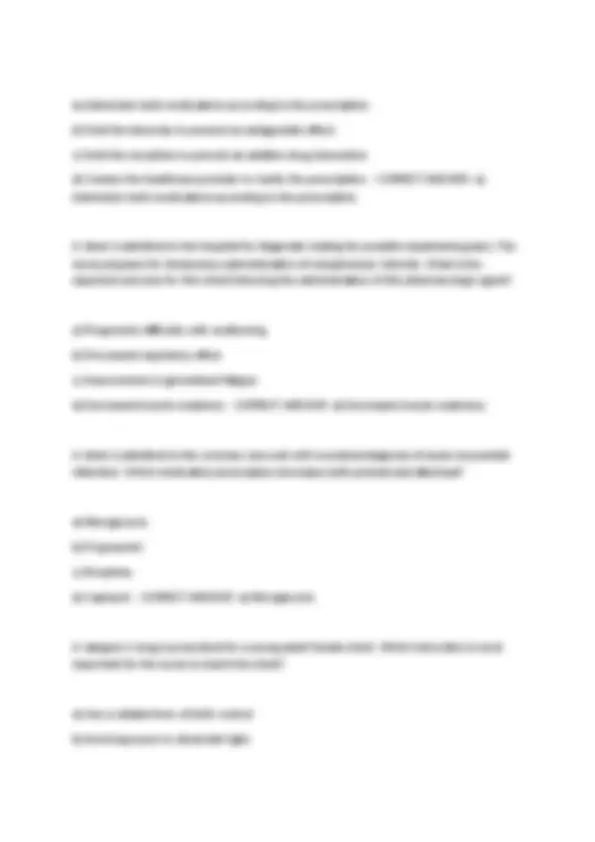
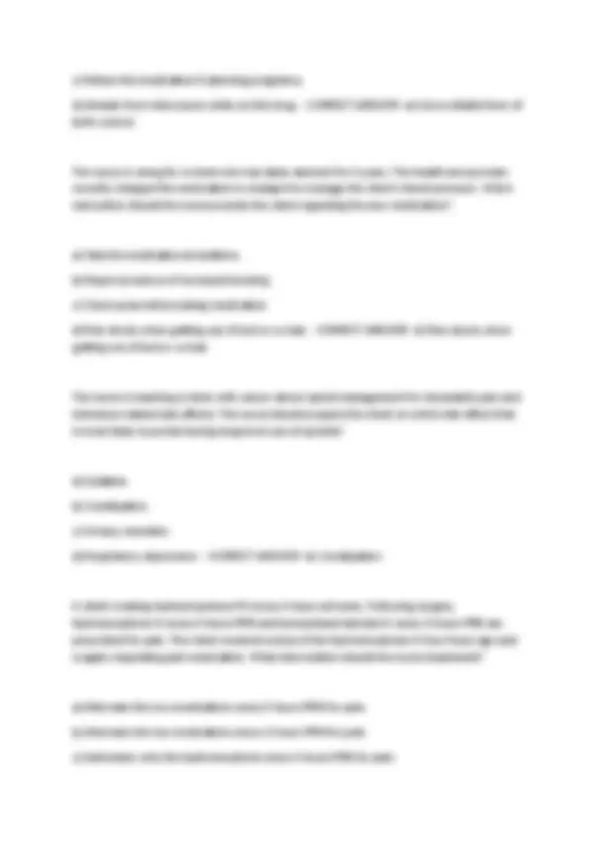
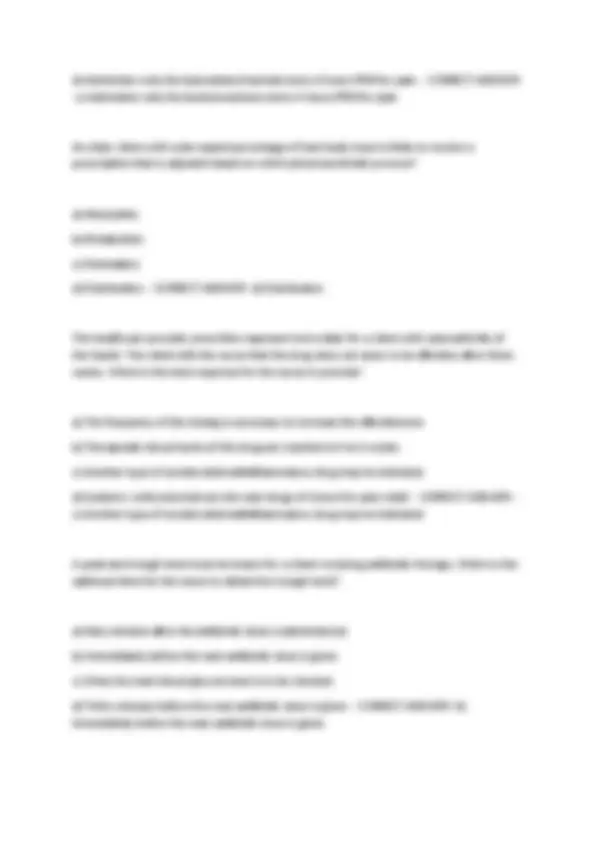
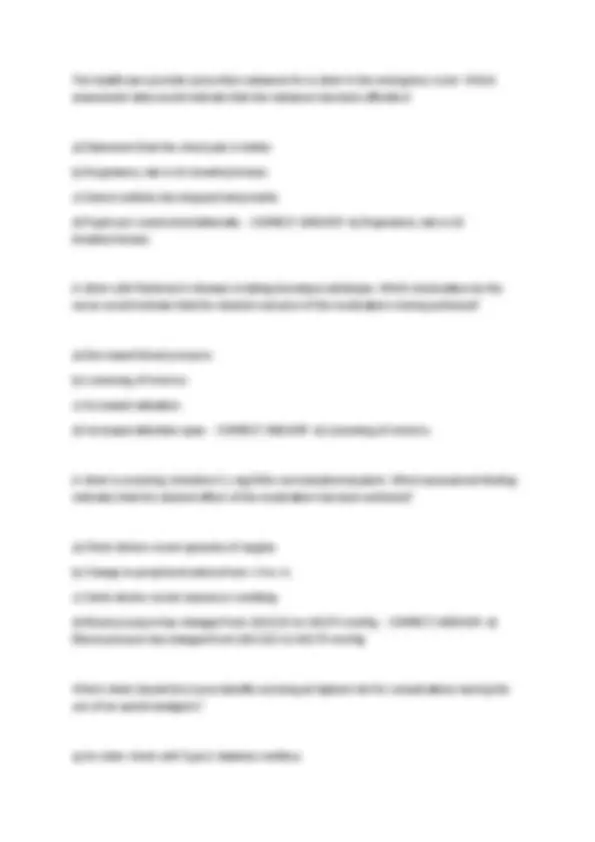
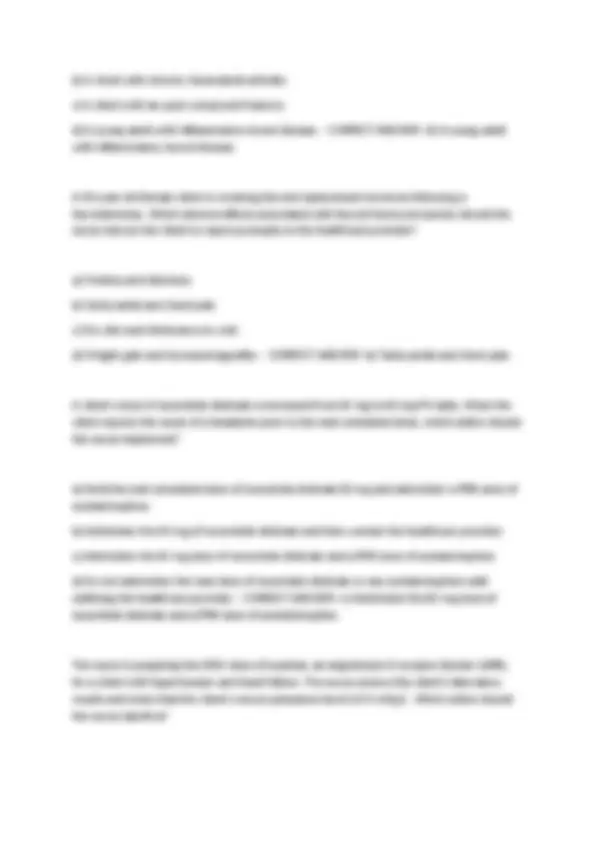
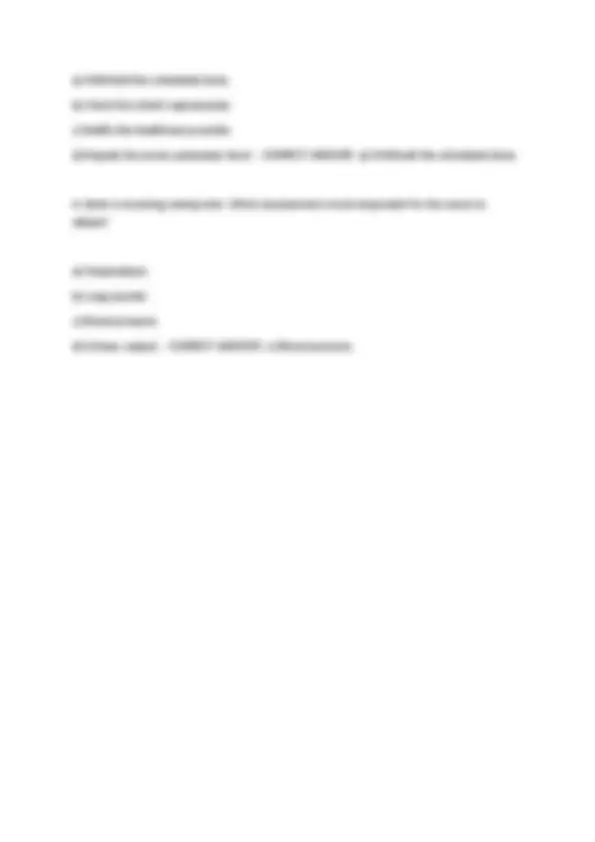


Study with the several resources on Docsity

Earn points by helping other students or get them with a premium plan


Prepare for your exams
Study with the several resources on Docsity

Earn points to download
Earn points by helping other students or get them with a premium plan
Community
Ask the community for help and clear up your study doubts
Discover the best universities in your country according to Docsity users
Free resources
Download our free guides on studying techniques, anxiety management strategies, and thesis advice from Docsity tutors
BSN 315 HESI PHARMACOLOGY EXAM NIGHTGALE NEWEST 2025 ACTUAL EXAM COMPLETE 250 QUESTIONS AND CORRECT DETAILED ANSWERS A client with osteoarthritis receives a new prescription for celecoxib orally for symptom management. The nurse notes the client is allergic to sulfa. Which action is most important for the nurse to implement prior to administering the first dose? a) Review the client's hemoglobin results. b) Notify the healthcare provider. c) Inquire about the reaction to sulfa. d) Record the client's vital signs. - CORRECT ANSWER -b) Notify the healthcare provider. The nurse is making early morning rounds on a group of clients when a client begins exhibiting symptoms of an acute asthma attack. The nurse administers a PRN prescription for a Beta 2 receptor agonist agent. Which client response should the nurse expect? a) Tachycardia b) Increased blood pressure c) Rapid resolution of wheezing d) Improved pulse oximetry values
Typology: Exams
1 / 23

This page cannot be seen from the preview
Don't miss anything!
















A client with osteoarthritis receives a new prescription for celecoxib orally for symptom management. The nurse notes the client is allergic to sulfa. Which action is most important for the nurse to implement prior to administering the first dose? a) Review the client's hemoglobin results. b) Notify the healthcare provider. c) Inquire about the reaction to sulfa. d) Record the client's vital signs. - CORRECT ANSWER - b) Notify the healthcare provider. The nurse is making early morning rounds on a group of clients when a client begins exhibiting symptoms of an acute asthma attack. The nurse administers a PRN prescription for a Beta 2 receptor agonist agent. Which client response should the nurse expect? a) Tachycardia b) Increased blood pressure c) Rapid resolution of wheezing d) Improved pulse oximetry values e) Reduced fever and airway inflammation - CORRECT ANSWER - a) Tachycardia c) Rapid resolution of wheezing d) Improved pulse oximetry values
Which change in data indicates to the nurse that the desired effect of the angiotensin II receptor antagonist valsartan has been achieved? a) Dependent edema reduced from +3 to + b) Serum HDL increased from 35 to 55 mg/dl c) Pulse rate reduced from 150 to 90 beats/minute d) Blood pressure reduced from 160/90 to 130/80 mmHg - CORRECT ANSWER - d) Blood pressure reduced from 160/90 to 130/80 mmHg The nurse is assessing the effectiveness of high-dose aspirin therapy for an 88-year-old client with arthritis. The client reports that she can't hear the nurse's questions because her ears are ringing. Which action should the nurse implement? a) Refer the client to an audiologist for evaluation of her hearing. b) Advise the client that this is a common side effect of aspirin therapy. c) Notify the healthcare provider of this finding immediately. d) Ask the client to turn off her hearing aid during the exam. - CORRECT ANSWER - c) Notify the healthcare provider of this finding immediately. The nitrate isosorbide dinitrate is prescribed for a client with angina. Which instruction should the nurse include in this client's discharge teaching plan? a) Quit taking the medication if dizziness occurs. b) Do not get up quickly. Always rise slowly. c) Take the medication with food only. d) Increase your intake of potassium-rich foods. - CORRECT ANSWER - b) Do not get up quickly. Always rise slowly. Which medications should the nurse caution the client about taking while receiving an opioid analgesic?
with a rate of 58 beats/minute, and a P-R interval of 0.24. Based on this assessment, what intervention should the nurse implement? a) Lower the head of the bed and assess the client for orthostatic vital sign changes. b) Give the medication as prescribed and continue to monitor the client. c) Prepare to administer atropine sulfate IVP. d) Hold the prescribed dose and contact the healthcare provider. - CORRECT ANSWER - b) Give the medication as prescribed and continue to monitor the client. When assessing an adolescent who recently overdosed on acetaminophen, it is most important for the nurse to assess for pain in which area of the body? a) Flank b) Abdomen c) Chest d) Head - CORRECT ANSWER - b) Abdomen A client with heart failure is prescribed spironolactone. Which information is most important for the nurse to provide to the client about diet modifications? a) Do not add salt to foods during preparation. b) Refrain from eating foods high in potassium. c) Restrict fluid intake to 1000 ml per day. d) Increase intake of milk and milk products. - CORRECT ANSWER - b) Refrain from eating foods high in potassium. Which method of medication administration provides the client with the greatest first-pass effect? a) Oral
b) Sublingual c) Intravenous d) Subcutaneous - CORRECT ANSWER - a) Oral Which nursing diagnosis is important to include in the plan of care for a client receiving the angiotensin-2 receptor antagonist irbesartan? a) Fluid volume deficit b) Risk for infection c) Risk for injury d) Impaired sleep patterns - CORRECT ANSWER - c) Risk for injury Upon admission to the emergency center, an adult client with acute status asthmaticus is prescribed this series of medications. In which order should the nurse administer the prescribed medications? (Arrange from first to last.) a) Prednisone orally b) Gentamicin IM c) Albuterol puffs d) Salmeterol - CORRECT ANSWER - c) Albuterol puffs d) Salmeterol a) Prednisone orally b) Gentamicin IM A client asks the nurse if glipizide is an oral insulin. Which response should the nurse provide? a) "Yes, it is an oral insulin and has the same actions and properties as intermediate insulin."
a) Increase consumption of potassium-rich foods since low potassium levels can cause muscle spasms. b) Have serum electrolytes checked at the next scheduled appointment to assess hyponatremia, a cause of cramping. c) Make an appointment to see the healthcare provider, because muscle pain may be an indication of a serious side effect. d) Be sure to consume a low-cholesterol diet while taking the drug to enhance the effectiveness of the drug. - CORRECT ANSWER - c) Make an appointment to see the healthcare provider, because muscle pain may be an indication of a serious side effect. A client with heart failure (HF) is being discharged with a new prescription for the angiotensin-converting enzyme (ACE) inhibitor captopril. The nurse's discharge instructions should include reporting which problem to the healthcare provider? a) Weight loss. b) Dizziness. c) Muscle cramps. d) Dry mucous membranes. - CORRECT ANSWER - b) Dizziness. Which dosing schedule should the nurse teach the client to observe for a controlled-release oxycodone prescription? a) As needed. b) Every 12 hours. c) Every 24 hours. d) Every 4 to 6 hours. - CORRECT ANSWER - b) Every 12 hours. A client with dysrhythmia is to receive procainamide in 4 divided doses over the next 24 hours. Which dosing schedule is best for the nurse to implement? a) Every 6 hours.
b) QID. c) AC and bedtime. d) PC and bedtime. - CORRECT ANSWER - a) Every 6 hours. Which symptoms are serious adverse effects of beta-adrenergic blockers such as propranolol? a) Headache, hypertension, and blurred vision. b) Wheezing, hypotension, and AV block. c) Vomiting, dilated pupils, and papilledema. d) Tinnitus, muscle weakness, and tachypnea. - CORRECT ANSWER - b) Wheezing, hypotension, and AV block. Which antidiarrheal agent should be used with caution in clients taking high dosages of aspirin for arthritis? a) Loperamide. b) Probantheline. c) Bismuth subsalicylate. d) Diphenoxylate hydrochloride with atropine. - CORRECT ANSWER - c) Bismuth subsalicylate. The nurse is reviewing the use of the patient-controlled analgesia (PCA) pump with a client in the immediate postoperative period. The client will receive morphine 1 mg IV per hour basal rate with 1 mg IV every 15 minutes per PCA to a total of 5 mg IV maximally per hour. Which assessment has the highest priority before initiating the PCA pump? a) The expiration date on the morphine syringe in the pump. b) The rate and depth of the client's respirations. c) The type of anesthesia used during the surgical procedure.
a) Assess pupillary response to light. b) Instruct the client that facial flushing may occur. c) Apply continuous cardiac monitoring. d) Request that family members leave the room. - CORRECT ANSWER - c) Apply continuous cardiac monitoring. Which instruction(s) should the nurse give to a female client who just received a prescription for oral metronidazole for the treatment of Trichomonas vaginalis? a) Increase fluid intake, especially cranberry juice. b) Do not abruptly discontinue the medication; taper use. c) Check blood pressure daily to detect hypertension. d) Avoid drinking alcohol while taking this medication. e) Use condoms until treatment is completed. f) Ensure that all sexual partners are treated at the same time. - CORRECT ANSWER - a) Increase fluid intake, especially cranberry juice. d) Avoid drinking alcohol while taking this medication. e) Use condoms until treatment is completed. f) Ensure that all sexual partners are treated at the same time. Which nursing intervention is most important when caring for a client receiving the antimetabolite cytosine arabinoside for chemotherapy? a) Hydrate the client with IV fluids before and after infusion. b) Assess the client for numbness and tingling of extremities. c) Inspect the client's oral mucosa for ulcerations. d) Monitor the client's urine pH for increased acidity. - CORRECT ANSWER - c) Inspect the client's oral mucosa for ulcerations.
After abdominal surgery, a male client is prescribed low molecular weight heparin (LMWH). During the administration of the medication, the client asks the nurse why he is receiving this medication. Which is the best response for the nurse to provide? a) This medication is a blood thinner given to prevent blood clot formation. b) This medication enhances antibiotics to prevent infection. c) This medication dissolves any clots that develop in the legs. d) This abdominal injection assists in the healing of the abdominal wound. - CORRECT ANSWER - a) This medication is a blood thinner given to prevent blood clot formation. A client is being treated for hyperthyroidism with propylthiouracil. The nurse knows that the action of this drug is to? a) Decrease the amount of thyroid-stimulating hormone circulating in the blood. b) Increase the amount of thyroid-stimulating hormone circulating in the blood. c) Increase the amount of T4 and decrease the amount of T3 produced by the thyroid. d) Inhibit synthesis of T3 and T4 by the thyroid gland. - CORRECT ANSWER - d) Inhibit synthesis of T3 and T4 by the thyroid gland. Following the administration of sublingual nitroglycerin to a client experiencing an acute anginal attack, which assessment finding indicates to the nurse that the desired effect has been achieved? a) Client states chest pain is relieved. b) Client's pulse decreases from 120 to 90. c) Client's systolic blood pressure decreases from 180 to 90. d) Client's SaO₂ level increases from 92% to 96%. - CORRECT ANSWER - a) Client states chest pain is relieved.
a) Heartburn. b) Headache. c) Constipation. d) Vomiting. - CORRECT ANSWER - d) Vomiting. The healthcare provider prescribes digitalis for a client diagnosed with heart failure. Which intervention should the nurse implement prior to administering the digitalis? a) Observe respiratory rate and depth. b) Assess the serum potassium level. c) Obtain the client's blood pressure. d) Monitor the serum glucose level. - CORRECT ANSWER - b) Assess the serum potassium level. While taking a nursing history, the client states, "I am allergic to penicillin." Which related allergy to another type of antiinfective agent should the nurse ask the client about when taking the nursing history? :a) Aminoglycosides b) Cephalosporins c) Sulfonamides d) Tetracyclines - CORRECT ANSWER - b) Cephalosporins Following heparin treatment for a pulmonary embolism, a client is being discharged with a prescription for warfarin. In conducting discharge teaching, the nurse advises the client to have which diagnostic test monitored regularly after discharge? a) Perfusion scan. b) Prothrombin Time (PT/INR). c) Activated partial thromboplastin (APTT).
d) Serum warfarin level (SCL). - CORRECT ANSWER - b) Prothrombin Time (PT/INR) A client is receiving ampicillin sodium for a sinus infection. The nurse should instruct the client to notify the healthcare provider immediately if which symptom occurs? a) Rash. b) Nausea. c) Headache. d) Dizziness. - CORRECT ANSWER - a) Rash A client has myxedema, which results from a deficiency of thyroid hormone synthesis in adults. Which medication would be contraindicated for this client? a) Liothyronine to replace iodine b) Furosemide for relief of fluid retention. c) Phentobarbital sodium for sleep. d) Nitroglycerin for angina pain. - CORRECT ANSWER - c) Phentobarbital sodium for sleep. The nurse is transcribing a new prescription for spironolactone for a client who receives an angiotensin-converting enzyme (ACE) inhibitor. Which action should the nurse implement? a) Verify both prescriptions with the healthcare provider. b) Report the medication interactions to the nurse manager. c) Hold the ACE inhibitor and give the new prescription. d) Transcribe and send the prescription to the pharmacy. - CORRECT ANSWER - a) Verify both prescriptions with the healthcare provider. A female client calls the clinic and talks with the nurse to inquire about a possible reaction after taking amoxicillin for 5 days. She reports having vaginal discomfort, itching, and a white discharge. The nurse should discuss which action with the client?
c) Red blood cells d) Serum potassium - CORRECT ANSWER - a) Serum glucose A medication that is classified as a beta-1 agonist is most commonly prescribed for a client with which condition? a) Glaucoma b) Hypertension c) Heart failure d) Asthma - CORRECT ANSWER - c) Heart failure Which drug is used as a palliative treatment for a client with tumor-induced spinal cord compression? a) Morphine sulfate b) Ibuprofen c) Amitriptyline d) Dexamethasone - CORRECT ANSWER - d) Dexamethasone In teaching a client who had a liver transplant about cyclosporine, the nurse should encourage the client to report which adverse response to the healthcare provider? a) Changes in urine color b) Presence of hand tremors c) Increasing body hirsutism d) Nausea and vomiting - CORRECT ANSWER - b) Presence of hand tremors
A client has a continuous IV infusion of dopamine and an IV of sodium chloride at 50 mL/hour. The nurse notes that the client's urinary output has been 20 mL/hour for the last two hours. Which intervention should the nurse initiate? a) Stop the infusion of dopamine. b) Change the sodium chloride to a keep-open rate. c) Replace the urinary catheter. d) Notify the healthcare provider of the urinary output. - CORRECT ANSWER - d) Notify the healthcare provider of the urinary output. An antacid, calcium carbonate, is prescribed for a client with peptic ulcer disease. The nurse knows that the purpose of this medication is to? a) Decrease production of gastric secretions. b) Produce an adherent barrier over the ulcer. c) Maintain a gastric pH of 3.5 or above. d) Decrease gastric motor activity. - CORRECT ANSWER - c) Maintain a gastric pH of 3.5 or above. A client is being treated for osteoporosis with alendronate, and the nurse has completed discharge teaching regarding medication administration. Which morning schedule would indicate to the nurse that the client teaching has been effective? a) Take medication, go for a 30-minute morning walk, then eat breakfast. b) Take medication, rest in bed for 30 minutes, eat breakfast, go for a morning walk. c) Take medication with breakfast, then take a 30-minute morning walk. d) Go for a 30-minute morning walk, eat breakfast, then take medication. - CORRECT ANSWER - a) Take medication, go for a 30-minute morning walk, then eat breakfast. An adult client has prescriptions for morphine sulfate 2.5 mg IV every 6 hours and ketorolac 30 mg IV every 6 hours. Which action should the nurse implement?
c) Refuse this medication if planning pregnancy. d) Abstain from intercourse while on this drug. - CORRECT ANSWER - a) Use a reliable form of birth control. The nurse is caring for a client who has taken atenolol for 2 years. The healthcare provider recently changed the medication to enalapril to manage the client's blood pressure. Which instruction should the nurse provide the client regarding the new medication? a) Take the medication at bedtime. b) Report presence of increased bruising. c) Check pulse before taking medication. d) Rise slowly when getting out of bed or a chair. - CORRECT ANSWER - d) Rise slowly when getting out of bed or a chair. The nurse is teaching a client with cancer about opioid management for intractable pain and tolerance-related side effects. The nurse should prepare the client on which side effect that is most likely to persist during long-term use of opioids? a) Sedation. b) Constipation. c) Urinary retention. d) Respiratory depression. - CORRECT ANSWER - b) Constipation. A client is taking hydromorphone PO every 4 hours at home. Following surgery, hydromorphone IV every 4 hours PRN and butorphanol tartrate IV every 4 hours PRN are prescribed for pain. The client received a dose of the hydromorphone IV four hours ago and is again requesting pain medication. What intervention should the nurse implement? a) Alternate the two medications every 4 hours PRN for pain. b) Alternate the two medications every 2 hours PRN for pain. c) Administer only the hydromorphone every 4 hours PRN for pain.
d) Administer only the butorphanol tartrate every 4 hours PRN for pain. - CORRECT ANSWER